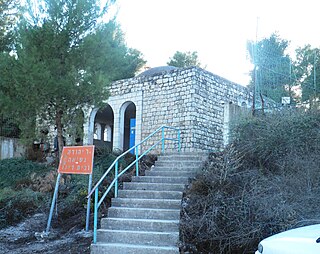
Judah ha-Nasi or Judah I, known simply as Rebbi or Rabbi, was a second-century rabbi and chief redactor and editor of the Mishnah. He lived from approximately 135 to 217 CE. He was a key leader of the Jewish community in Roman-occupied Judea after the Bar Kokhba revolt.

Shimon bar Yochai or Shimon ben Yochai, also known by the acronym Rashbi, was a 2nd-century tanna or sage of the period of Roman Judaea and early Syria Palaestina. He was one of the most eminent disciples of Rabbi Akiva. The Zohar, a 13th-century foundational work of Kabbalah, is ascribed to him by Kabbalistic tradition, but this claim is universally rejected by modern scholars.

Judah II or Nesi'ah I was a Jewish sage who lived in Tiberias in the Land of Israel, in the middle of the third century CE.

Modzitz, or Modzhitz, is the name of a Hasidic group within Orthodox Judaism that derives its name from Modrzyce, one of the boroughs of the town of Dęblin, Poland, located on the Vistula River.
Bar Kappara was a Jewish scholar of the late second and early third century CE. He was active in Caesarea Maritima, the capital of the Roman province of Syria Palaestina, from around 180 to 220 CE. His name, meaning "Son of Qappara", was taken from his father, Eleazar ha-Kappar. He was one of the students of Judah ha-Nasi and a first-generation amora.
Rabbi Meir was a Jewish sage who lived in the time of the Mishnah. He was one of the Tannaim of the fourth generation (139-163). He is the third most frequently mentioned sage in the Mishnah and is mentioned over 3,000 times in the Babylonian Talmud. His wife Bruriah is one of the few women cited in the Gemara.

Vayishlach or Vayishlah is the eighth weekly Torah portion in the annual Jewish cycle of Torah reading. In the parashah, Jacob reconciles with Esau after wrestling with a "man." The prince Shechem rapes Dinah, whose brothers sack the city of Shechem in revenge. In the family's subsequent flight, Rachel gives birth to Benjamin and dies in childbirth.
Simeon ben Azzai or simply Ben Azzai was a distinguished tanna of the first third of the 2nd century.
The Ten Martyrs were ten rabbis living during the era of the Mishnah who were martyred by the Roman Empire in the period after the destruction of the Second Temple. Their story is detailed in Midrash Eleh Ezkerah.
Helpetha I, commonly mispronounced Halafta, was a rabbi who lived in Sepphoris in the Galilee during the late 1st and early 2nd centuries CE. He was the father of Jose ben Helpetha and Shimon ben Helpetha, also serving as their teacher. He is cited without patronymic or cognomen in the Mishnah, but as Abba Helpetha in the Talmuds.
Jose ben Helpetha, commonly known as Jose ben Halafta (IPA:) was a tanna of the fourth generation. He is the fifth-most-frequently mentioned sage in the Mishnah. Yose Ben Halafta is the one of two rabbis called Rabbi Yose in the Talmud; the other being Jose ben Zimra, an amora.
Hanina ben Dosa was a first-century Jewish scholar and miracle-worker and the pupil of Yohanan ben Zakkai. He is buried in the town of Arraba in the Lower Galilee.
Pardes is the subject of a Jewish aggadah ("legend") about four rabbis of the Mishnaic period who visited the pardes, only one of whom succeeded in leaving the pardes unharmed.
Eleazar ben Shammua or Eleazar I was a rabbi of the 2nd century, frequently cited in rabbinic writings as simply Rabbi Eleazar (Bavli) or Rabbi Lazar רִבִּי לָֽעְזָר (Yerushalmi). He was of priestly descent and rich, and acquired great fame as a teacher of traditional law.
Ishmael ben Jose was a rabbi who lived at the beginning of the 3rd century. He was the son of Jose ben Halafta.

Allusions in rabbinic literature to the Biblical character Job, the object of sufferings and tribulations in the Book of Job, contain various expansions, elaborations and inferences beyond what is presented in the text of the Bible itself.

Kfar Hananya is a community settlement in the Galilee in northern Israel under the administration of the Merom HaGalil Regional Council. In 2022 it had a population of 781.The village marks the border between the historic Upper and Lower Galilee regions. Lower Galilee is defined in the Mishnah as the area south of Kfar Hananya where the Sycamore Fig tree grows.
Rav Aha b. Rava was a Babylonian rabbi.
Eleazar b. Shimon was a Jewish Tanna sage of the fifth generation, contemporary of R. Judah ha-Nasi.
Rabbi Simeon ben Jehozadak was a rabbi who was one of the semi-tannaim on the border between the eras of tannaim and amoraim.







